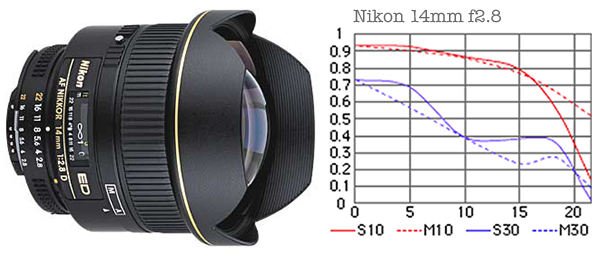14mm Group Test
Lens Specifications
All MTF charts manufacturers' own. Like-for-like comparison is invalid
 Canon 14mm f2.8 L (New:$1700 / Used:$1100)
Canon 14mm f2.8 L (New:$1700 / Used:$1100)
The L is the smallest, lightest and by far the most expensive of the group at 77mm in length and 560g, cramming in 14 elements in 10 groups. The build quality, however is superb, with butter smooth focus and a substantial metal lens cap that fits so snugly over the obscenely bulbous front element that you'll be taking it on and off for fun. Close focus is 25cm.
 Nikon 14mm f2.8 EDIF (New:$1300 / Used:$800)
Nikon 14mm f2.8 EDIF (New:$1300 / Used:$800)
Conspicuously of very similar design to the Canon, Nikon's version also has 14 elements, this time in 12 groups, 85mm in length and weighing 652g. It, too, is a marvel of Japanese engineering fully equal to its rival in construction terms. Bringing a new, literal – and quite unwelcome – dimension to the term lens 'hood', Nikon ship this fabulously expensive lens with a floppy faux-leather fabric thing that entirely fails to protect the lens in use, and is a royal pain to put back on. Here's a little secret, though: the Sigma 12-24mm and 15-30mm hoods fit the petal 'shade' perfectly and give you a proper filter ring. Don't leave home without one. Close focus is 20cm.
 Sigma 12-24mm f4.5-5.6 DG (New:$600 / Used:$450)
Sigma 12-24mm f4.5-5.6 DG (New:$600 / Used:$450)
In keeping with Sigma's 'big and light' policy, the 12-24mm feels like it largely consists of air compared to the dense little primes. 102mm long and 600g in weight, it's an entirely new 16 element / 12 group design which has broken new ground in design terms: other than the Voigtlander Super Wide Heliar, no other rectilinear full frame lens this wide exists – yet. In use, it clearly doesn't feel as expensive as the primes, but it certainly doesn't seem shoddily put together either. Zoom and focus rings come out of the factory too tight but loosen somewhat over time. Close focus is 28cm.